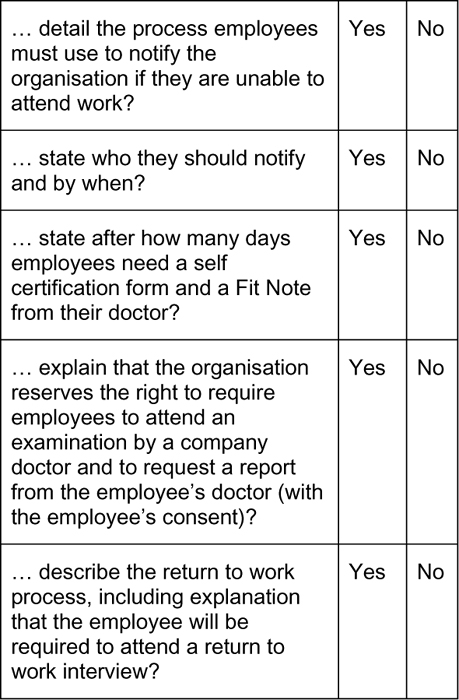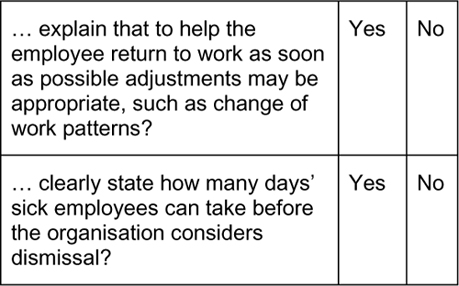CHAPTER 1: INTRODUCTION
Why this pocket guide?
When a member of staff is unexpectedly absent from work it raises immediate cause for concern with regard to:
• the likelihood of missing deadlines
• disruption to the quality and continuity of service delivery
• increased workload and pressure for team members who take on other’s work
• time invested by managers and team leaders in resourcing and HR issues
• costs involved in hiring temporary or replacement staff
• loss of productivity and efficiency
• drop in motivation and employee engagement and commitment
• decrease in internal and external customer satisfaction and retention
• reputational risk for the organisation of not providing an excellent service.
The annual cost of unplanned absenteeism is estimated to run to between £10 and £12 billion in the UK. On average, each employee has 8.3 days’ unplanned absence from work each year. Studies show that unauthorised absence is most likely to occur in certain groups, such as younger people, new starters, manual workers and people who work in larger organisations where absenteeism is not so readily noticed. However, recent force majeure events, such as bad weather and airport closures have proven that unplanned absenteeism can affect many thousands of people in businesses across the globe.
In this book I offer practical advice to help you better manage unplanned absences, so as to minimise the impact on you, your colleagues and team members, your customers and business reputation.
Reasons for absence
Let’s start by considering the causes of absence from work, remembering that there are many valid reasons why people can be absent. These include authorised holidays, compassionate leave, time off to care for dependents, paternity and maternity leave, adoption and parental leave, study leave, as well as time off for jury service and trade union duties. Employees have a legal right to be absent for these and many other reasons. If you are unsure about employee rights, a good source of reference is the Acas website: www.acas.org.uk.
The focus of this book is unauthorised, unplanned absence. This can be caused by short- or long-term sickness, including stress, persistent lateness or ‘duvet days’, where employees decide not to show for work. Sometimes called ‘Monday morning syndrome’, this type of absence may be linked to major sporting events or national holiday periods e.g. taking an unplanned absence either side of a Bank Holiday. It can also be caused by external factors, such as weather and travel disruption.
Preparation to prevent being caught out
There are a number of practical actions that you and your organisation can take to minimise the incidence of unplanned absence and to ensure the smooth operation of your business, should unplanned absenteeism occur.
Step 1: Ensure that expectations of attendance are set out in employee contracts
Make sure that employee contracts of employment refer to regular and punctual attendance and that the agreed attendance times are clear. This will reduce any risk of the employee claiming that there was flexibility on hours of attendance, if this was not the case.
Step 2: Have a clear absence management policy
A fundamental step is to ensure that your organisation has a clear policy in place that outlines information on employee terms and conditions relating to taking time off work. This is a legal requirement and should be made clear to all employees. Typically, this policy is contained in an employee handbook. I suggest that you find a copy of this (or ensure one is created) now.
Check that your policy is comprehensive. In addition to legislative details, such as statutory sick pay and contractual sick play, does your policy:
Table 1: Assess your absence
management policy

Now is a good time to review your policy to identify how your policy and procedures cover employees who are absent due to circumstances beyond their control (the closure of airports because of the volcanic ash eruption is one example). Does your policy make it clear where the employee stands? Does time lost need to be taken as holiday entitlement, for example? Is it clear what the reporting and return to work arrangements will be?
Step 3: Ensure that line managers, team leaders and supervisors, as well as team members, are aware of the policy
Having a robust HR policy is all very well, but people need to be aware of it and how it operates on a daily basis. If you are concerned, or anticipate that unplanned absenteeism is on the rise, make sure that your policy is well communicated. In particular, place emphasis on the fact that the employee’s line manager will conduct a return to work interview as soon as they come back to work. Holding a return to work interview has been proven to be the most effective way of reducing unplanned absenteeism (with the exception of unplanned absenteeism which has arisen because of force majeure).
Step 4: Provide training to line managers to help prevent absenteeism and effectively implement the policy
Research by The Gallup Organisation shows that a person’s direct line manager has the greatest influence over how engaged employees are in the organisation and how prepared they are to give discretionary effort. How managers and supervisors behave has a direct impact on motivation and morale. Studies show that the incidence, for example, of workplace stress is on the rise and that employees cite management behaviour as one of the biggest causes of stress.
In order to promote well-being in the workplace and to minimise unplanned absenteeism, managers need to promote effective, two-way communication. Often unplanned leave of absence is a symptom of underlying malaise or breakdown in the relationship between manager and team member. By holding regular one-to-one discussions, being available and approachable, managers can encourage employees to open up about issues and problems before they escalate. Key to effective management of unplanned absenteeism is the manager’s ability to identify the underlying causes. For example:
• Is the employee under too much or too little pressure at work?
• Are their duties appropriate?
• Have they been provided with sufficient training to do their job well?
• What are their relationships with others like at work?
• What impact do their working patterns or conditions have on them?
• What is the quality of their supervision and management?
• What factors outside work might need to be taken into consideration?
Providing manager, team leader and supervisor training is a great way to ensure that they best manage absenteeism. For example, has your organisation provided training to managers on the following items?
Table 2: Training line managers in absence
management

Step 5: Monitor and measure unplanned absenteeism
In order to make objective and informed decisions about absence management, you will need to ensure you have facts and figures to hand. Best practice is to measure and monitor employee absence on a regular basis. This can be done by assessing aspects, such as the total absence (in days or hours) over a certain period, how often these occur and the spells of absence. This will provide an indication of the disruption caused. It is useful to provide managers with benchmark information, so that they can compare their absenteeism rates with other parts of the organisation. It is also useful to report on each function’s / department’s rates of absenteeism. This will help senior managers and HR professionals identify and take steps to action hot spots or underlying trends.
Step 6: Be flexible
Aim to be flexible when it comes to holiday leave and sudden requests for days off. If you turn these down repeatedly, employees may simply take unplanned and unauthorised leave. Discuss with your team how work can be covered over busy and holiday periods and when there are major incidents, such as sporting events or flight cancellations.
Plan ahead. If you know that you have members of your team travelling on business or pleasure during periods of travel disruption, prepare contingency plans and ensure that your organisation has access to expert travel advice.
If you know that a major sporting event, for example, is likely to be happening, plan measures to make provisions for this. Some organisations, for instance, ensure that there are televisions in rest rooms and staff areas, so that employees can keep up to date with events.
Step 7: Consider setting attendance targets and attendance incentives
There is a saying: ‘what gets measured gets done’. If your organisation needs to improve its unplanned absenteeism rates, consider setting this as a target or Key Performance Indicator (KPI) for each team. This KPI can be included in performance management or as part of a balanced scorecard approach.
Some organisations set ‘attendance triggers’, for example, if a team member has had four spells of unplanned absence in a six month period. This would then lead to a performance management discussion and the creation of an improvement plan.
If you do decide to go down the disciplinary route, make sure that your absence policy is clear about how many days’ sickness employees can take before the organisation will consider dismissal.
A further method is to incentivise good attendance. You could consider providing time off in lieu or other token reward to employees with minimum levels of unplanned absenteeism. However, a critique of this method is that regular attendance should be part of an employee’s contract of employment and incentives only have short-term effects.
Step 8: Involve occupational health professionals
If unplanned absenteeism is an issue for your organisation, one strategy is to involve occupational health professionals. They can help identify the causes of underlying pressures or issues that prevent employees from giving their best and provide advice on ways to ensure greater levels of ‘presenteeism’.
Step 9: Utilise disciplinary procedures for unacceptable levels of unplanned absenteeism
Many of the steps above involve a ‘carrot’ approach to driving down unplanned absenteeism. If all else fails, and unplanned absence is a regular event, a ‘stick’ approach is to go down the disciplinary approach. Take careful HR advice before starting this route.
Step 10: Make contingency plans
Given the global nature of today’s business and the unforeseen events that arise, the chances are that unplanned absenteeism will occur in your team, in spite of all your good endeavours. From a pragmatic point of view, my advice is to use the checklists and tips in the remainder of this book to help you prepare for absenteeism. In this way, you will be able to minimise disruption and cost.


